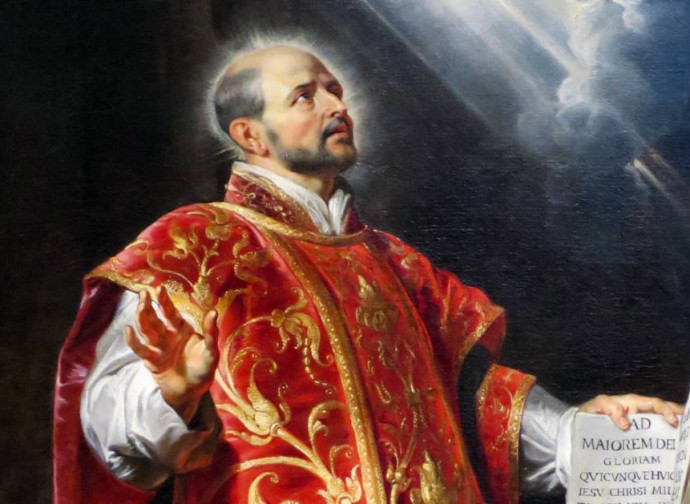Saint Ignatius of Loyola
Before choosing holiness and consecrating his life to the greater glory of God, Saint Ignatius of Loyola (1491-1556) had had a rather turbulent youth. The great protagonist of the Catholic Reformation was the last of 13 children of a couple of the high Spanish nobility, who had baptized him with the name of Iñigo.

Before choosing holiness and consecrating his life to the greater glory of God, Saint Ignatius of Loyola (1491-1556) had had a rather turbulent youth. The great protagonist of the Catholic Reformation was the last of 13 children of a couple of the high Spanish nobility, who had baptized him with the name of Iñigo. He lost his mother shortly after his birth and his father during his adolescence. According to the custom of the time he was destined for an ecclesiastical career, but he showed a preference for the knight's life. He lived for 11 years on the estate of the minister Juan Velázquez, among comforts, banquets, and reading adventure stories. He was a skilful musician and dancer, as well as a bold participant in knightly tournaments, even ending up on trial for some excesses during Carnival.
He was then employed by a gentleman as an armed knight. He fought valiantly in the defence of the fortress of Pamplona, which was eventually conquered by the French, and was hit by a cannonball that shattered his right leg. It was 20 May 1521 and Iñigo was already thirty years old. He recovered after very painful operations, but his injured leg was now shorter than the other and forced him to limp for the rest of his earthly days. And yet, the long convalescence proved to be providential. His sister-in-law had given him to read the Vita Christi by the Carthusian monk Ludolph of Saxony and the Golden Legend by Blessed Jacobus da Varagine. After reading these, the adventures of the knights began to appear ephemeral and to pale into insignificance compared to the extraordinary lives of the saints. So he decided to become a “soldier of Jesus Christ”. He visited the sanctuary of Montserrat. And here, after a general confession and a vigil dedicated to the Virgin, he stripped himself of his military vestments and laid them before an image of Our Lady.
He became a penitent in Manresa, where he lived for about a year between a monastery and a cave, where he received “great enlightenment”. He began to write some meditations that would later be included in his Spiritual Exercises, the famous work that Pius XI would define four centuries later as “the most wise and universal spiritual code for directing souls”. But why did the saint, who in the meantime had taken the name Ignatius, choose such a title? He explained it himself in the introduction: “By this name of Spiritual Exercises is meant every way of examining one’s conscience, of meditating, of contemplating, of praying vocally and mentally, and of performing other spiritual actions, as will be said later. For as strolling, walking and running are bodily exercises, so every way of preparing and disposing the soul to rid itself of all the disordered tendencies, and, after it is rid, to seek and find the Divine Will as to the management of one’s life for the salvation of the soul, is called a Spiritual Exercise”.
He went on pilgrimage to the Holy Land, visiting the places where the mysteries of the Redemption were accomplished, and which were so central to his Exercises to help man enter into the logic of God. He returned to Spain, and later studied at the University of Paris. It was in the French city that another pivotal event took place. On 15 August 1534 he and six other companions, among them the future Saints Francis Xavier and Peter Faber, made a vow in the chapel of Montmartre: thus was born what would later officially become the Society of Jesus. Its peculiarity was the fourth vow of special obedience to the Pope, linked to the promise to go wherever the Holy Father commanded to take the proclamation of Christ. A true godsend for the Church, which in those years was torn apart by the propagation of Luther's heresies, to which the Jesuits responded by founding one college after another to teach the new Catholic generations.
Ignatius, unanimously elected first General Provost of the new religious order, wrote the Constitutions, which reflected his missionary vocation and the principle of militant action in the service of the Church. A principle well summarized in his motto Ad maiorem Dei gloriam and in the so-called meditation of the Two Standards [‘standard’ as in ‘flag’], contained in the Exercises, which calls man to the necessary spiritual combat and to the choice between the Standard of Christ, “Supreme Captain and Our Lord”, and that of Lucifer, “mortal enemy of human nature”. The choice, which is valid for eternity and is enclosed in the incarnation of three virtues or, on the contrary, three vices, is made here and now.
After years of serious illness he died in Rome, where Paul III had already asked him to remain while his confreres (there were already about a thousand at the time of his death) were departing on various missions. As we read in the Autobiography, dictated to a priest friend and written in the third person, the thought of death made him feel “great consolation” at the idea of the eternal enjoyment of heavenly goods, of which he had a preview during his earthly life: “Sometimes he saw God the Father, sometimes the three Persons of the Trinity, sometimes Our Lady interceding for him and reassuring him”.
Learn more:




